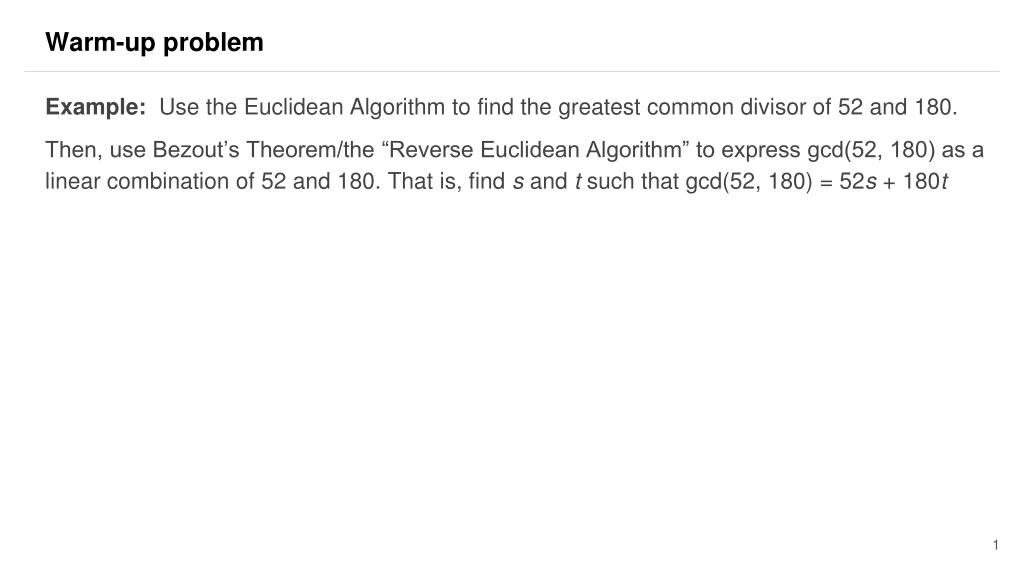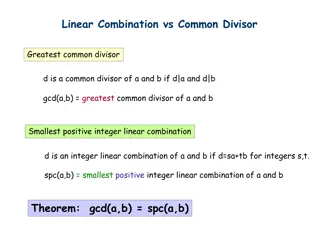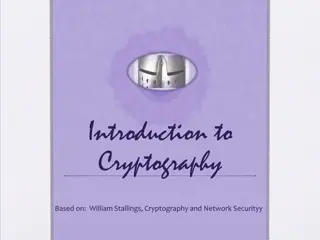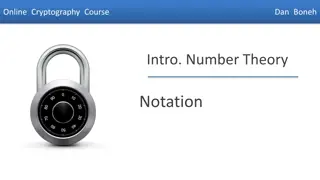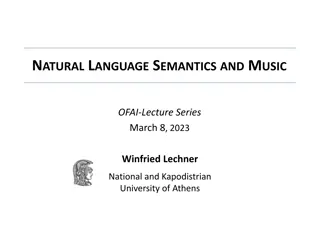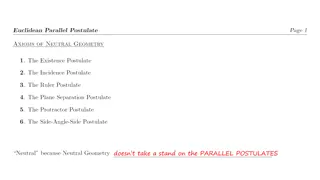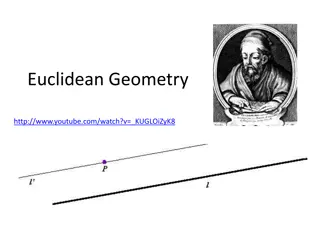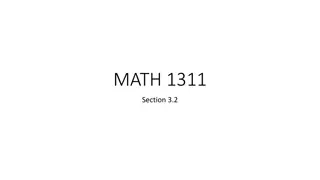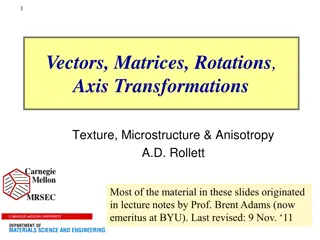Understanding Linear Congruences and the Euclidean Algorithm in Number Theory
Exploring concepts of linear congruences using examples like finding times congruent to 2 o'clock and applying the Euclidean Algorithm to determine the greatest common divisor of 52 and 180. Learn about Bezout's Theorem for expressing GCD as a linear combination of the given numbers.
Download Presentation

Please find below an Image/Link to download the presentation.
The content on the website is provided AS IS for your information and personal use only. It may not be sold, licensed, or shared on other websites without obtaining consent from the author. Download presentation by click this link. If you encounter any issues during the download, it is possible that the publisher has removed the file from their server.
E N D
Presentation Transcript
Warm-up problem Example: Use the Euclidean Algorithm to find the greatest common divisor of 52 and 180. Then, use Bezout s Theorem/the Reverse Euclidean Algorithm to express gcd(52, 180) as a linear combination of 52 and 180. That is, find s and t such that gcd(52, 180) = 52s + 180t 1
Warm-up problem Example: Use the Euclidean Algorithm to find the greatest common divisor of 52 and 180. Then, use Bezout s Theorem/the Reverse Euclidean Algorithm to express gcd(52, 180) as a linear combination of 52 and 180. That is, find s and t such that gcd(52, 180) = 52s + 180t Euclidean Algorithm to find gcd(52, 180): 180 = 52 3 + 24 (note that 52 3 = 156) 52 = 24 2 + 4 24 = 4 6 + 0 Bezout s Theorem/ reverse Euclidean Algorithm gives: gcd = last nonzero remainder = 4 gcd(52, 180) = 4 = 52 - 24 2 = 52 - (180 - 52 3) 2 = 52 - 2 180 + 6 52 = 7 52 - 2 180 2
CSCI 2824, Discrete Structures Spring 2018 Alexandra Kolla Lecture 20: Solving Congruences 3
Announcements and reminders HW 7 (Moodle) is due Friday at 12 PM. Lots of CodeRunner, so start it early! If you have concerns about how your exam was graded: 1) Check the solutions first. 2) Put in writing what specifically you want me to look at. 3) Bring this note and your exam to me by Friday (9 March) 4
What did we do last time? Sieve of Eratosthenes, Trial Division -- finding prime numbers Euclidean Algorithm -- find greatest common divisors (GCDs) Fundamental Theorem of Arithmetic -- can write numbers as product of primes Today: Solving congruence relations 5
Solving congruences Definition: A congruence of the form ax b (mod m) where m is a positive integer, a and b are integers and x is a variable is called a linear congruence. Goal: Find all integers x that satisfy this congruence. Example: What are all of the times that are congruent to 2 o clock? Want x 2 mod 12 6
Solving congruences Linear congruence: ax b (mod m) This is analogous to the linear equation: ax = b One way to solve this simple equation is to multiply both sides by 1/a: x = b/a Here, we use the fact that 1/a is the multiplicative inverse of a Recall that 1/a is the multiplicative inverse of a because (1/a) a = 1 We ll use the same strategy to solve the linear congruence. 7
Solving congruences Linear congruence: ax b (mod m) Strategy: Find a number such that The number is called the inverse of a modulo m If we know the inverse, then we can find the solution to the linear congruence by 8
Solving congruences Example: Solve 3x 4 (mod 7) 9
Solving congruences Example: Solve 3x 4 (mod 7) Note that 5 3 = 15 = 2 7 + 1 1 (mod 7) Note that -2 would also work So the inverse of 3 modulo 7 is 5 Multiplying both sides of the linear congruence by 5 gives x 5 4 (mod 7) 20 (mod 7) 6 (mod 7) So any x that is congruent to 6 mod 7 is a solution. E.g., 6, 13, 20, -1, Check: 3 6 = 18 = 2 7 + 4 4 (mod 7) Check: 3 -1 = -3 = -1 7 + 4 4 (mod 7) 10
Solving congruences Okay! So if we can find the inverse of a (mod m) then we can solve the linear congruence ax b (mod m) Important Question #1: Does such an inverse always exist? Important Question #2: If so, can we find it more systematically? (than our previous method of thinking really hard 11
Solving congruences Theorem: If a and m are relatively prime, then an inverse of a modulo m exists 12
Solving congruences Theorem: If a and m are relatively prime, then an inverse of a modulo m exists Proof: S pose a and m are relatively prime. gcd(a, m) = 1 Bezout s theorem tells us that there exist integers s and t such that sa + tm = 1 this implies that sa + tm 1 (mod m) but tm 0 (mod m), so it must be the case that sa 1 (mod m) So s must be the inverse of a (mod m) that we re after Note: This proof also shows us how to actually find the inverse 13
Solving congruences The inverse of a is exactly the coefficient s from Bezout s theorem, and we saw last time how to find such an s Example: Determine the inverse of 19 modulo 141 Step 1: Do the Euclidean algorithm to confirm that gcd(19,141) = 1 14
Solving congruences The inverse of a is exactly the coefficient s from Bezout s theorem, and we saw last time how to find such an s Example: Determine the inverse of 19 modulo 141 Step 1: Do the Euclidean algorithm to confirm that gcd(19,141) = 1 141 = 7 19 + 8 19 = 2 8 + 3 8 = 2 3 + 2 3 = 1 2 + 1 2 = 2 1 + 0 Since the last remainder was 1, the Euclidean algorithm tells us that 19 and 141 are relatively prime, and theorem applies there is an inverse of 19 (mod 141) 15
Solving congruences The inverse of a is exactly the coefficient s from Bezout s theorem, and we saw last time how to find such an s Example: Determine the inverse of 19 modulo 141 Step 2: Do the Euclidean algorithm in reverse to find the coefficient on 19 141 = 7 19 + 8 19 = 2 8 + 3 8 = 2 3 + 2 3 = 1 2 + 1 2 = 2 1 + 0 16
Solving congruences The inverse of a is exactly the coefficient s from Bezout s theorem, and we saw last time how to find such an s Example: Determine the inverse of 19 modulo 141 Step 2: Do the Euclidean algorithm in reverse to find the coefficient on 19 1 = 3 - 1 2 = 3 - 1 (8 - 2 3) = 3 - 1 8 + 2 3 = 3 3 - 1 8 = 3 (19 - 2 8) - 1 8 = 3 19 - 6 8 - 1 8 = 3 19 - 7 8 = 3 19 - 7 (141 - 7 19) = 3 19 - 7 141 + 49 19 = 52 19 - 7 141 141 = 7 19 + 8 19 = 2 8 + 3 8 = 2 3 + 2 3 = 1 2 + 1 2 = 2 1 + 0 So 52 is the inverse of 19 (mod 141) 17
Solving congruences Example: Solve the linear congruence 19x 4 (mod 141) 18
Solving congruences Example: Solve the linear congruence 19x 4 (mod 141) Solution: Multiplying both sides of the congruence by 52 (the inverse of 19 modulo 141) gives: x 52 4 (mod 141) 208 (mod 141) 67 (mod 141) 19 67 = 1273 = 9 141 + 4 4 (mod 141) Check: 19 349 = 6631 = 47 141 + 4 4 (mod 141) (349 = 67 + 2 141) 19
Solving congruences Example? Solve the linear congruence 2x 3 (mod 4) Example? Solve the linear congruence 2x 2 (mod 4) 20
Solving congruences FYOG: Solve the linear congruence 5x 4 (mod 17) FYOG: Solve the linear congruence 55x 34 (mod 89) FYOG: Show that the integers between (and including) 2 and 9 can be broken up into pairs, where the two numbers in each pair are one another s inverse modulo 11. FYOG: Use the previous result to show that 10! -1 (mod 11) 21
Solving congruences Recap: To solve a congruence relation of the form ax b (mod m) 1. Verify that a and m are relatively prime using the Euclidean Algorithm. If they are, an inverse of a (mod m) exists. 2. Use the reverse Euclidean Algorithm to find the inverse of a (modulo m) 3. Multiply both sides of ax b (mod m) by the inverse of a (modulo m) to get a congruence relation for x Next time: We started today off making the analogy between linear equations and the linear congruences that we learned how to solve today. Next, we ll see there is also a natural analogy to systems of linear congruences (the last piece we need before cryptosecurity!) 22
Bonus material! 23
FYOG: hints! FYOG: Solve the linear congruence 5x 4 (mod 17) Step 1: Do the Euclidean algorithm to confirm that gcd(5, 17) = 1 17 = 3 5 + 2 5 = 2 2 + 1 2 = 2 1 + 0 So gcd(5, 17) = 1, so an inverse exists (by the theorem in today s lecture). To find it, we can use the Euclidean algorithm in reverse: 1 = 5 - 2 2 = 5 - 2 (17 - 3 5) = 7 5 - 2 17 So 7 is the inverse of 5 modulo 17. Step 2: Multiply both sides of the linear congruence by 7... 24
FYOG: hints! FYOG: Solve the linear congruence 55x 34 (mod 89) Step 1: Do the Euclidean algorithm to confirm that gcd(55, 89) = 1 To find the inverse of 55 modulo 89, we can use the Euclidean algorithm in reverse, just as in the last FYOG example. You should find that the inverse is 34. Step 2: Multiply both sides of the linear congruence by 34... 25
FYOG: hints! FYOG: Show that the integers between (and including) 2 and 9 can be broken up into pairs, where the two numbers in each pair are one another s inverse modulo 11. (2, 6) -- because 2 6 = 12 1 (mod 11) And so on FYOG: Use the previous result to show that 10! -1 (mod 11) 10! = 10 9 8 7 6 5 4 3 2 1 = 10 (9 5) (8 7) (6 2) (4 3) 10 (1) (1) (1) (1) (mod 11) And 10 -1 (mod 11) (since 11 | (10 - (-1)) ) 26
